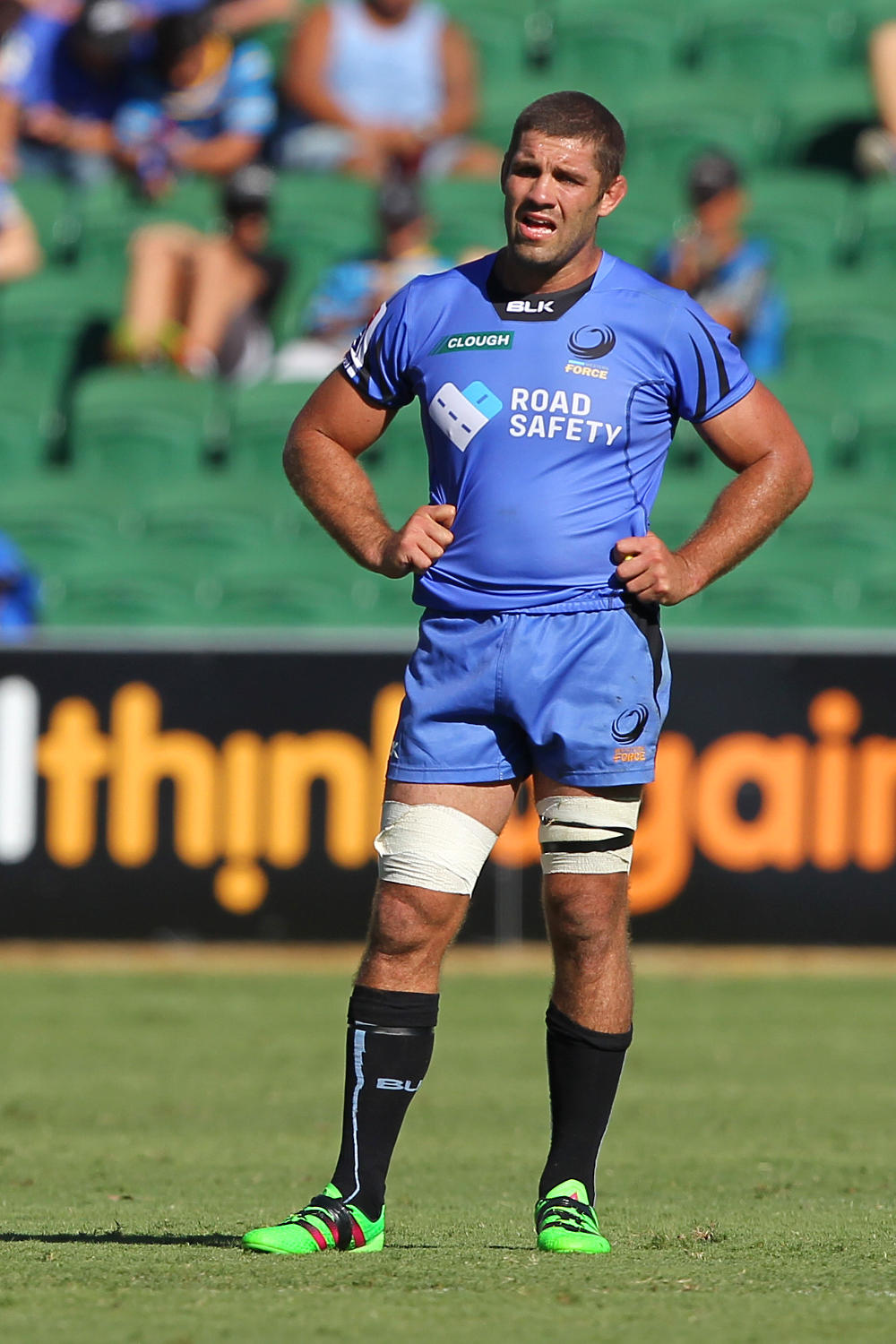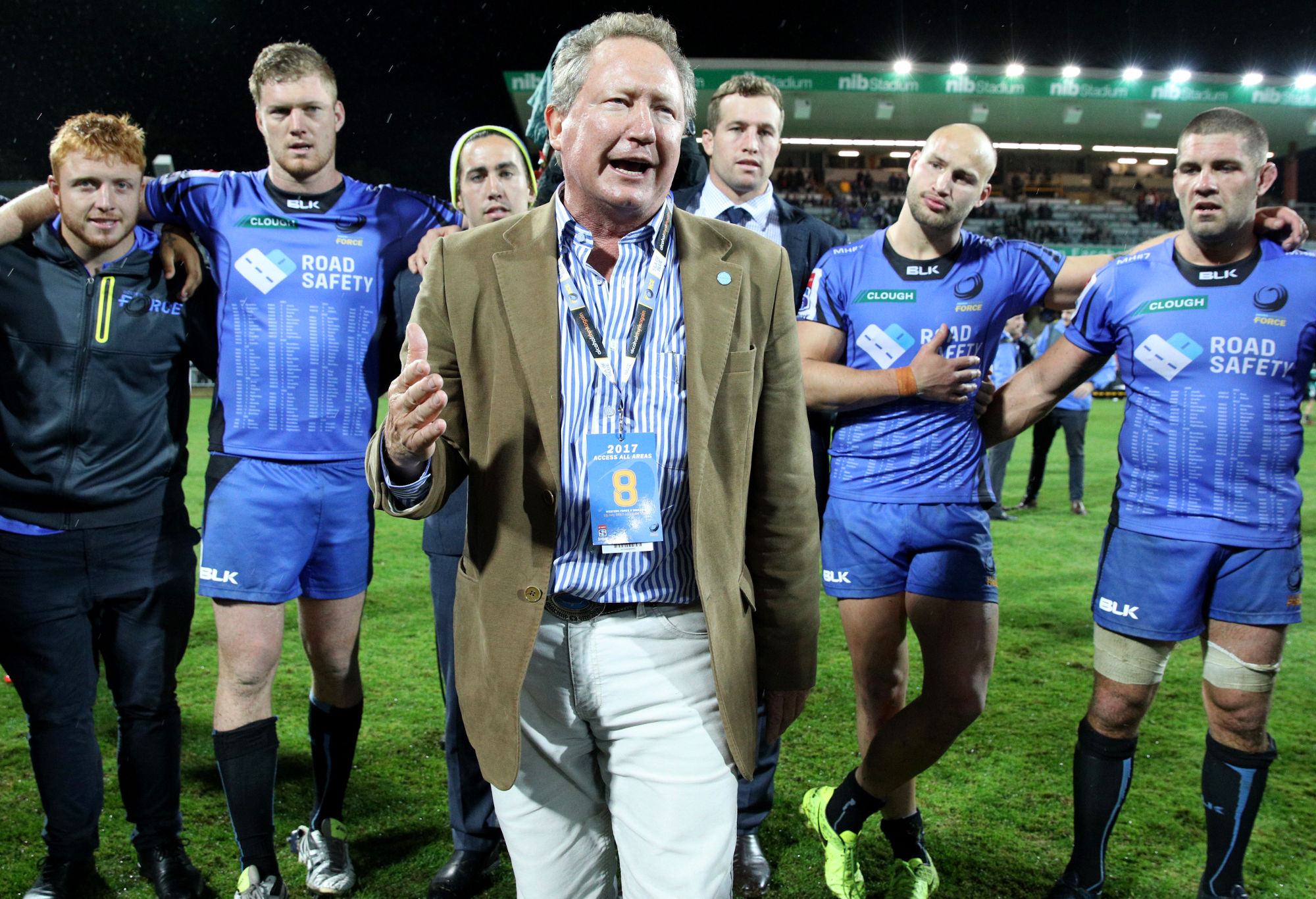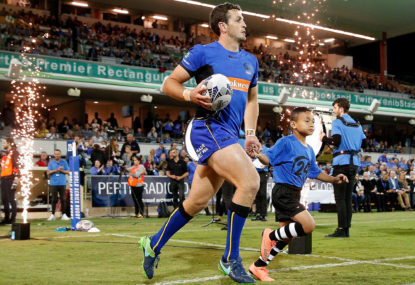On July 15 last year, Matt Hodgson kicked a final-minute penalty goal to stamp a 40-11 thumping of the Waratahs, and to mark the final act of the Western Force in Super Rugby.
It also drew the curtain down on Hodgson’s stellar 11-cap, 140-game Super Rugby career.
In ‘normal’ times, Hodgson might have drifted off into a graceful retirement, but with the removal of the Force from Super Rugby creating a schism between east and west, and Andrew Forrest pledging to provide professional rugby for WA fans, Hodgson’s life took a whirlwind turn.
Racking up countless air miles, now juggling multiple mobile phones and a schedule packed with wall-to-wall meetings requires all of Hodgson’s renowned tenacity and endurance. But there can be no mistake that he exudes genuine belief that what will form a looming announcement (likely in early-September) will not only honour the commitment made by Forrest to Western Australia, but herald a new advance for the way in which professional rugby is played and is delivered to fans.
“Initially I wasn’t motivated by the idea of a big professional tournament”, Hodgson explains. “My goal was to create a pathway for local juniors, but after more time I saw that there were certain things within rugby that needed to change, and it became clear that with a new competition, new ideas and new people, we could start something that could re-energise rugby, not just in Western Australia, but in Australia and around the world.”
With late Feb-early March slated as a start date for World Series Rugby (this name has been favoured over the previously mooted Indo-Pacific Rugby Championship), time is running short to finalise the myriad logistical requirements an international professional competition entails.

(AAP Image/Richard Wainwright)
But while Hodgson isn’t about to dilute the impact of an upcoming launch, and laughs off speculation about team locations, he leaves no room for doubt that the competition he is putting together will cause the rest of the rugby world to sit up and take notice.
“This year was all about re-launching the Force, next year will be all about a brand new, exciting competition, and beyond that, while we do have long term plans, we expect things to shift around as we look at what works and doesn’t work, and as new opportunities open up around the world.”
Ahead of any formal announcement, the rumour mill is abuzz with speculation that suggests WSR will offer five-year licences to eight participating teams, including two from Japan, Hong Kong, Singapore, Fiji, New Zealand (based in North Harbor) and Western Sydney.
Given that teams in Australia and New Zealand would require the sanction of the respective national unions, either that speculation is off-target or there is still much work to complete before the competition detail is actually finalised.
Because WSR is currently synonymous with the Force, an independent board and commission of clubs will be established to administer the competition – although exactly how ‘independent’ will be viewed with interest, given the concept’s Perth origins and its underwriting via the largesse of Forrest.
Forrest’s ‘investment’, made through his philanthropic Minderoo Foundation, includes the carrot of a $1m purse for the winning side and meeting the inevitable shortfall that will exist between player salaries and other operating costs, and revenue obtained through sponsorships, gate and broadcasting rights.
It is intended that ownership of the Force will be returned to WA rugby fans, many of whom showed their preparedness to support their side by pledging money to a fighting fund during their vain bid to remain in Super Rugby.
If there are any uncertainties surrounding the start and long-term viability of WSR, one banker is the parochialism of the West Australian people. The underlying cultural factors that drove 69,000 people to attend the opening of Perth’s new Optus Stadium in January – without there being any event on – are the same ingredients that will underpin WSR, and the Force, moving into the next phase.
The healthy attendances for the Force’s home games this year – nothing more than exhibition matches, a number of them played in bad weather – also speak to a prevailing ‘up yours’ mentality; for many fans, these matches effectively doubling as protest rallies against Rugby Australia.
An ‘us versus them’ framework is unsustainable in the long run however, a point emphasised by Hodgson and seconded by Force captain Ian Prior.
“Our first game this year was bigger than winning and losing, it was about making a statement about rugby being back in WA,” Prior says.
“But the playing group moved on, we’re motivated by setting a pathway for players, setting a legacy for the Force, moving things forward for rugby in the state, and also trying to shake up some of the old mentality about how rugby can be made more entertaining for fans.”
[latest_videos_strip category=”rugby” name=”Rugby”]
For the impressive Prior, it has been a year of mixed emotions – pride at being appointed captain of the Force, the challenge of working with Tim Sampson and a brand new coaching team to establish a new team identity and style of play, and anticipation of what lies ahead next year with WSR.
But without real competition points to play for, there have been difficult moments too. Prior again: “The last three weeks have been the toughest in terms of keeping that motivation and training intensity up, in particular we’ve really had to work with some of the younger players in terms of things like nutrition and the way they prepare.”
Prior is also keen to emphasise the importance of retaining a pathway to Wallabies’ selection, regardless of what level the new competition settles at.
“Obviously we had Andrew Deegan and Tim Ferris play well in last week’s Wallabies trial. As long as we maintain a professional club with a strong academy program underneath, within a national footprint, you’d have to say, why not select players for the Wallabies?
“It’s no different than Matt Giteau and George Smith being picked out of club rugby and playing for the Wallabies before they played Super Rugby”, Prior adds.
So what is there to be said about the WSR match-day experience?
There are ticks for the friendliest ticket office and security staff I have ever encountered at a sporting event. Also, for keeping the curtain-raising youngsters on-field for longer, and having the players begin their warm-ups in the in-goal areas. And if you’ve got money to burn, a fireworks display and a spot of flame-throwing immediately before kick-off adds value for families attending.
Throw in a lively atmosphere in the corporate bar area, and the whole package accurately reflects Hodgson’s desire to provide an enjoyable outing for all of the traditional ‘pie and a beer’ rugby fan, families, children and corporate segments, and provides a superior atmosphere to a typical Super Rugby fixture.
Another notable off-field turn was Forrest himself, plainly relaxed and happy among ‘his people’. His aura is such that thankful fans position themselves for a handshake or a wave; the vibe, if you like, how you’d imagine a local community hall should Prince Harry decide to drop in on a CWA fundraiser.
On the field, the experimental law ‘innovations’ once again had little impact. Hodgson speaks of a desire to “increase ball in play time up to an average of 42-43 minutes”, and considers it a boon for World Rugby to have a professional competition in which rule variations can be tried and tested.
But rather than make an impact at the set piece, it is more likely we’ll see WSR provide future improvements around the elimination of down-time attached to incidental stoppages.
Despite neither side coming remotely close, the ‘power try’ has potential, with kids quick to identify opportunities via the flashing crossbar. As Hodgson says, “there is no actual need for cricket to have flashing bails, but it adds another level of interest and excitement.”
An intrusive ground announcer helped create an environment akin to a BBL match, which – just like the cricket – can be either a plus or a negative, depending on your viewpoint.
For viewers at home, the addition of on-screen tweets is an interesting way to incorporate fans into the coverage, but cutaways to mini player profiles while the match is live feels like a case of trying to pack too much innovation into too little space.
On-field player interviews should have died with Natalie Yoannidis and Henry Speight, but the WSR coverage persists. Reporter Adrian Barich asking an out-of-breath Force winger Clay Uyen, seconds after he sprinted for a try in the 63rd minute, “what does it mean to play for the Force?” added nothing but try-hard cringe value.
A kind assessment might be that the coverage from the commentary box and their supports is over-earnest. Another might suggest that everyone involved is not only on the blue-juice bandwagon, but the payroll.
As for the match itself, the Force were a yard faster than a brave but outclassed Hong Kong Dragons – a side largely made up of ex-pat Brits and Kiwis on the fringes of a national side soon to enter a 2019 World Cup repechage. A final score of 45-24 was fair justice on the night.
The Force’s first two tries were scored by man-of-the-match, fullback, Jack McGregor – the volume of cheers from the crowd lending a nice touch of irony, considering McGregor’s recent relocation from Melbourne.
Despite a fervent belief that the Force and WSR are bringing something different to rugby, there seems little justification so far for those claims. The laws and refereeing of the modern game ensure that almost all teams now play 15-man rugby.
Both sides scored two tries each from rolling lineout mauls and, despite the commentators repeatedly insisting we were watching something fresh and innovative, it all looked to me like… just another game of rugby.

(AAP Image/Richard Wainwright)
Looking ahead, expect a continuation of rabidly proud WA rugby fans spinning the competition as a dagger to the heart of Rugby Australia and, from the opposite side, skeptics pointing to a rich man’s plaything with rosters full of ‘no-names’ unable to secure contracts in Super Rugby or any of the three major European leagues.
Depending on what you want it to be, WSR will either be a resounding success, or it will be an underwhelming failure.
For as long as Forrest is prepared to bankroll the competition, then it will exist and succeed on its own terms, relative to the extent of his investment. Forrest doesn’t need to sign the world’s best players to deliver on his promise – it is probable that a legacy of WA rugby ‘white knight’, and facilitator of the development of second-tier rugby nations is a more realistic objective for him.
Almost certainly, WSR will feature many players who are unknown, unwanted, or who are perhaps staving off retirement. Matches will be of varying quality and, with no overall mechanism to ensure equalisation, there is high potential for disparity between the top and bottom sides – as there would be in any fledgling competition.
But WA rugby fans have demonstrated that they don’t need to see Beauden Barrett, Malcom Marx and Israel Folau to appreciate and support rugby. There are giant billboards of long since departed Alby Mathewson around town, but it isn’t the detail that is important.
WA having its own professional team in a real competition is enough, and if that competition happens to be over-hyped, and its existence relies totally on the depth of one individual’s pockets, it doesn’t matter one iota.
What is also clear is that the overreach and exaggerated discussion points, the petty arguments about crowd sizes, and a desire by some to continue to forensically dissect the injustices around the Force’s exclusion from Super Rugby are also not what matters.
What is important is that, by whatever means, there is professional rugby in the state, that provides an aspirational pathway for young players, and that will retain and attract fans to the sport.
In the meantime, hidden away out of the limelight, is WA Rugby, financially stricken, who negotiated a settlement out of administration after losing a court case they brought against Rugby Australia over the manner in which they were exited from Super Rugby, and who still owe in the vicinity of $1.6m to the West Australian government.
A meeting was held last week between the various stakeholders charged with running club rugby, schools rugby, women’s rugby officials, aimed at mapping out their future. It is a blessing for them that the arrival of WSR, and the clarification of a governance structure around that competition and the Force, will eventually allow them to re-assert their own identity – although there is concern that the financial constraints under which they operate are still considerable and are not readily compatible with the growth of the game at grassroots level, in the state.
To this end, there is a financial contribution from Minderoo, but residual resentment towards Rugby Australia that their contribution to grassroots rugby of $170,000 pa is insufficient.
For her part, Rugby Australia CEO Raelene Castle insists that there is goodwill at senior administrative level and, in the context of the astronomical costs borne by Rugby Australia associated with the legal action taken against them, and compliance costs with respect to two government inquiries, “the amount of direct financial assistance and assistance in kind provided to WA is in keeping with that provided to other states.”
“Also, with respect to World Series Rugby, Rugby Australia is providing event support, provides match officials, and meets 50 per cent of those expenses”, Castle added.
While antipathy towards RA Chairman Cameron Clyne remains, it was encouraging to hear the Force versus Hong Kong Dragons commentary team speak positively about Rugby Australia with respect to the recent trial match, the initiative to invite drought-stricken NSW farmers to the Bledisloe Cup, and the allocation of next year’s Bledisloe Cup match to Perth.
There is an old saying that ‘time heals all wounds’. When that happens, the Wanneroo juniors, Western Force and the Wallabies will be all the better for it.































































































